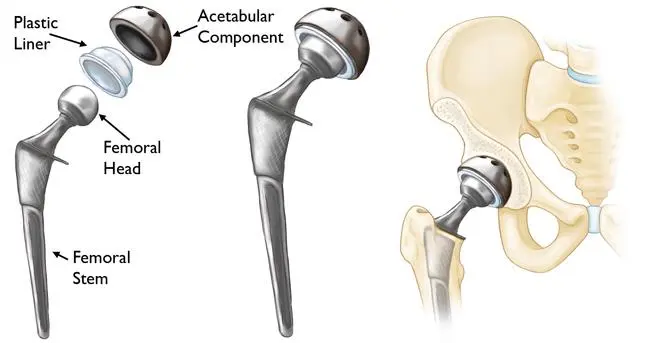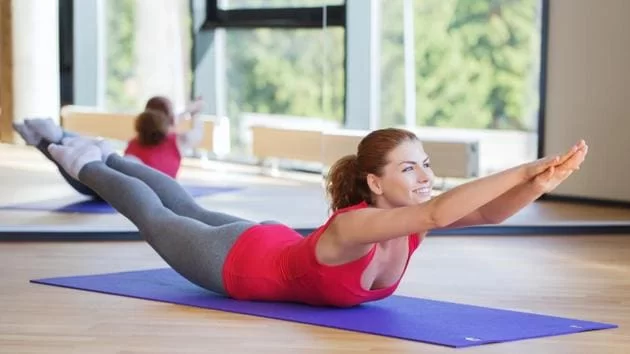Physical Therapy Rehab Protocol For Total Hip Replacement
Introduction
Hip arthroplasty, sometimes referred to as hip replacement, is an operation done to relieve hip pain. The use of artificial implants. throughout the hip joint replacement procedure. a ball, which is situated at the head of the femur, the thigh bone, and a disc.
Postoperative rehabilitation is crucial to ensure optimal recovery, mobility, and function after total hip replacement. Physical therapy plays a central role in guiding patients through a comprehensive rehabilitation protocol tailored to their individual needs. The primary goals of physical therapy following total hip replacement include reducing pain, restoring joint mobility, improving muscle strength, enhancing balance and coordination, and facilitating the return to daily activities.
The goal of this rehabilitation program is to give patients who have had total hip replacement surgery a methodical and gradual approach to postoperative treatment. The protocol is designed to handle several stages of recovery, taking into account the particular requirements and problems at each one. The primary goals of the first postoperative exercises are muscle activation, mild joint mobility, and pain control. The focus of rehabilitation gradually returns to functional activities, strengthening exercises, and weight-bearing exercises.
The hip joint is made up of a socket that is located in the pelvis, also referred to as the hip bone. The hip may need to have both or one part replaced. before the procedure to replace it. Your capacity to carry out regular tasks and participate in physical exercise while feeling less uncomfortable is the procedure’s main goal.
Major Three Types of Hip Replacement
Total hip replacement (most common)
The hip joint is removed during this surgical surgery and is replaced with a hip implant. Either a full replacement or a partial replacement can be carried out. Although it may sound difficult, one of the most popular orthopedic procedures is hip replacement.
Partial hip replacement
This operation does not replace the hip joint’s socket, in contrast to a total hip replacement. Rather, the joint’s ball is substituted. This is a typical operation for older patients, commonly after a hip fracture or a fall.
Hip resurfacing
A type of hip replacement surgery called hip resurfacing removes less bone from the joint. It works well on young people who have stronger bones. This surgery is currently only performed in a small number of UK hospitals, having grown less prevalent in recent years.
Indication For Hip Replacement
Osteoarthritis
Osteoarthritis, sometimes referred to as wear-and-tear arthritis, affects the flexible cartilage that protects the ends of bones and allows joint motion.
Rheumatoid Arthritis
An overactive immune system causes Rheumatoid Arthritis, which leads to swelling that can ruin joint cartilage and the joints may occasionally break and become malformed due to the underlying bone.
Osteonecrosis
If the ball of the hip joint does not receive enough circulation, the bone may collapse and swell. This might happen because of a fracture or dislocation. If hip discomfort continues, hip replacement may be an option. Persists, despite pain medication even with a cane or walker, Worsens with walking Interferes with sleep and restricts one’s ability to climb or descend stairs making it difficult to stand up from a sitting position
Risk Factor
The following are some possible dangers of hip replacement
Blood Clots
Leg vein clots may form following surgery. Because part of a clot may separate and move to the lung, heart, or, in rare cases, the brain, this can be harmful. Blood-thinning medications can reduce this risk.
Infection
At the incision site and in the deeper tissue close to the replacement hip, infections can develop. Antibiotics are often used to treat infections, however, a serious illness close to new Artificial parts in the hip may need to be removed and replaced surgically. Healthy parts of the hip joint might fracture during surgery. Smaller fractures may be able to heal on their own in certain cases, while bigger fractures may require the stabilization of wires, screws, a metal plate, or bone transplants.
Dislocation
The ball of the replacement joint may pop out of the socket in certain positions, particularly in the initial months after surgery. If the hip dislocates, a brace can help maintain the hip in the appropriate position. If the hip continues to move out of position, surgery may be required to fix it.
Change in leg length
Sometimes, all the steps surgeons take to avoid, a replacement hip lead to one leg being longer or shorter than the other. Muscles around the hip can sometimes contract, causing this. In these situations, gradually contracting and extending certain muscles could be beneficial.
Loosening
The new joint could not become firmly connected to the bone or it might become loose, even though this problem is uncommon with modern implants.
Nerve Damage
Nerve damage around the implant site is quite unlikely. Pain, weakness, and numbness can all be symptoms of nerve injury.
Blood Clot Prevention
Following hip replacement surgery, you will initially have a higher risk of getting blood clots in your legs.
Physiotherapy Following Your Hip Replacement
You must continue exercising after leaving the hospital since physiotherapy treatment is key to your rehabilitation. Your muscular strength and flexibility will increase as a result of receiving physiotherapy which will also speed up your return to normal function and mobility.
Rehabilitation goals include:
- Decreasing pain and swelling
- Maintaining and recovering the hip’s complete range of motion
- Increasing the strength of the glutes, hamstrings, and quadriceps
- Re-education of normal gait
- Increasing fitness and endurance
- Promoting independence with functional activities
- Improving quality of life
1-2 Weeks
You shouldn’t do some exercises within the first six weeks. For example, you should avoid twisting your hips inward and outward or crossing your legs. physiotherapist will give you more tip and advice to protect your hip.
The main goals of your two-week physiotherapy treatment are to reduce your discomfort and swelling, passively improve your range of motion, and strengthen your muscles. The goal of treatment will be to improve your mobility in your house and ambulation. At this point, physiotherapy treatments will consist of:
beginning of gait training while using crutches and a walker as assistive aids
Continuation of functional transfer training
Exercise progression and ROM progression according to the patient’s tolerance
progression of ambulation using the least restrictive equipment on flat surfaces and upstairs.
2-6 Weeks
At this stage of your rehabilitation, your physiotherapy program with Physio.co.uk will continue previous exercises to increase the range of movement with the addition of resistance exercises. Exercise will also help you become more independent in day-to-day tasks.
Gait re-education (with less assistance) and proprioception (balance) improvement are other treatment modalities. Physiotherapy exercises will comprise
Exercises to build strength include knee bends, sitting leg extensions, side-lying/standing hip abduction, standing hip extension, and hip abduction.
stretching activities to improve hip muscles’ flexibility
Progression of ambulation distance
Progression of independence with ADLs
Proprioception and balance training
Stationary bicycle as tolerated
6-12 Weeks
Your physiotherapist will concentrate on regaining your functional abilities at this stage of your rehabilitation so that you may resume your formerly enjoyable activities. To make sure you can safely complete your tasks, your progress will be closely watched. To guarantee the greatest possible recovery, your physiotherapist will guide and help you throughout your course. Your physical therapy treatment will involve several exercises to strengthen the muscles in your legs and the area surrounding your hips while also extending your hip’s range of motion. You can engage in exercises to improve your fitness levels, such as walking, hydrotherapy, and mild cycling.
12+ Weeks
Your commitment to your treatment plan will determine the extent of your recovery and how quickly you may return to your prior level. At this stage of your rehabilitation,n you will continue to improve with physiotherapy treatment so that you reach your maximum potential. a full recovery might take up to six months, physical treatment will improve your life quality and capacity for everyday tasks and sports.
Exercises For Total Hip Replacement
Ankle Pumps
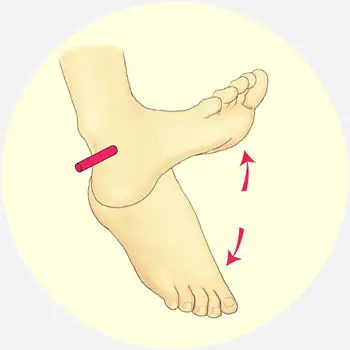
- Slowly push your foot up and down. Perform this exercise many times, usually every five to ten minutes. Every time an advertisement on television appears, you should kick your feet.
Ankle Rotations

- Turn your ankle so that it points in the direction of your other foot and then outward. Repeat 5 times in each direction. This exercise should take 3 minutes.
- Do – 3 to 4 times a day.
Bed-Supported Knee Bends
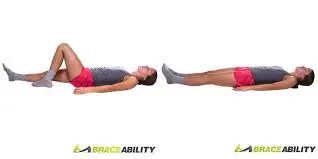
While maintaining your heel on the bed and bending your knee, slide your foot towards your buttocks. Avoid rolling your knee inward. For five to ten seconds, maintain your knee in the most bent position possible. Straighten your leg. Repeat 10 times. This exercise should take 3 minutes. perform this exercise 3 to 4 times a day.
Buttock Contractions
Push your buttocks tight and maintain the position for five counts. Repeat 10 times. This exercise should take 90 seconds. This exercise should be done three or four times a day.
Abduction Exercise

As far as possible, slide your leg out to the side, then back. Repeat 10 times. This exercise should take 90 seconds. Do 3 to 4 times a day
Quadriceps Set
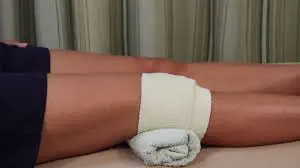
- Tighten your thigh muscles. Try to straighten your knee. Hold for 5 to 10 seconds. In ten minutes, perform this exercise ten times, take a one-minute break, and then repeat. Continue until your thigh feels fatigued. This exercise should take 2 minutes.
Straight Leg Raises

Tighten your thigh muscles with your knee fully straightened on the bed. Lift your leg several inches. Hold for 5 to 10 seconds. Slowly lower your leg. Repeat until your thigh feels fatigued. This exercise should take 2 minutes.
Resistive Hip Flexion

Stand with your feet slightly apart. Bring the operated leg forward while maintaining a straight knee. Put your leg back where it was before.
Resistive Hip Abduction
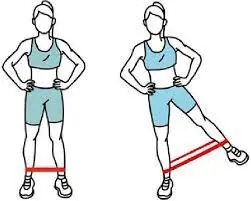
Place yourself opposite the door that the tubing connects to. You should stretch your operated leg to the side.
Put your leg back where it was before.
Resistive Hip Extension
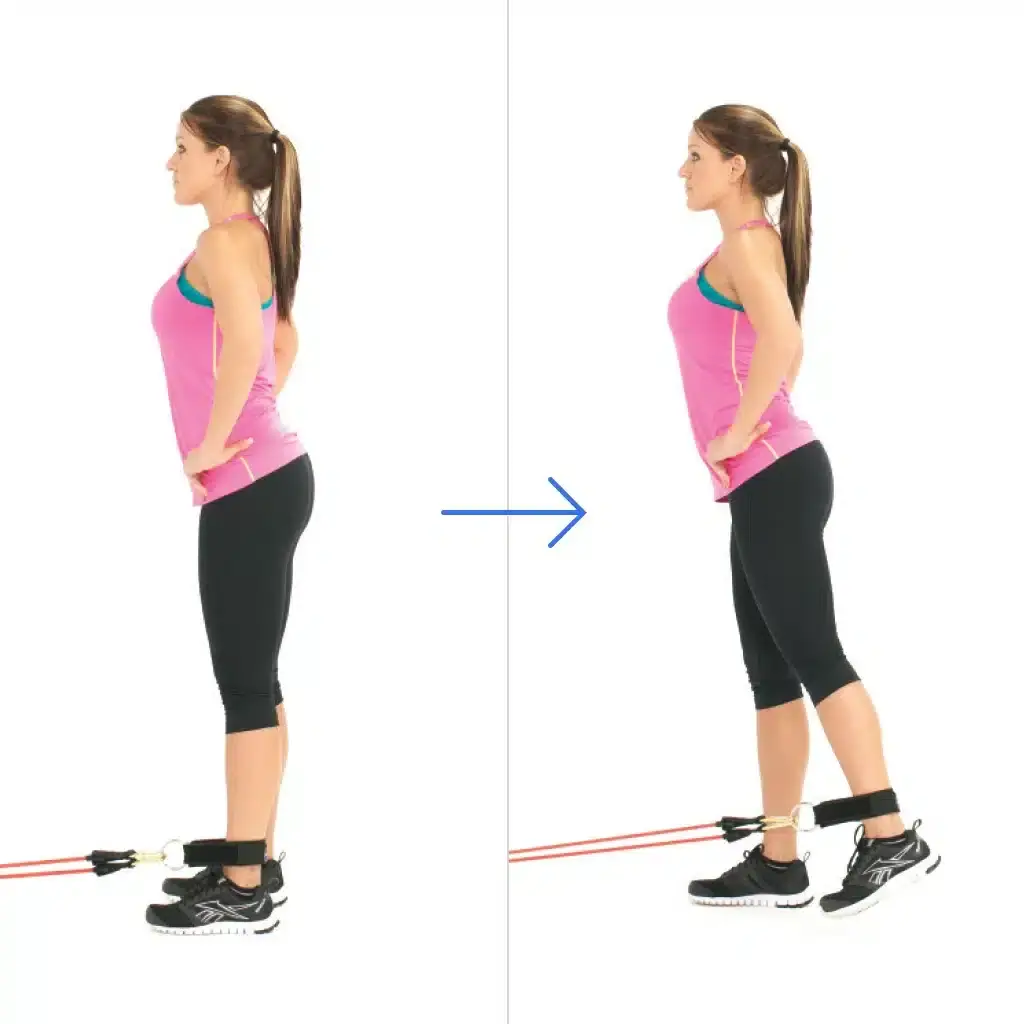
Face the door where the tubing connects with your back to it. Pull your leg straight back. Put your leg back in the position it was in before.
Standing Exercises
You will be able to stand and get out of bed shortly after your procedure. At first, you will need assistance, but as your strength returns, you will be able to stand on your own. Make sure you’re hanging onto something strong when performing these standing exercises, such as a wall or a bar that’s attached to your bed.
Standing Knee Raises
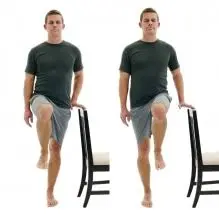
Lift your operated leg toward your chest. Never raise your knee over your waist. Hold for 2 or 3 counts. Put your leg down. Repeat 10 times. This exercise should take 3 minutes. Do this exercise 3 to 4 times a day.
Standing Hip Abduction
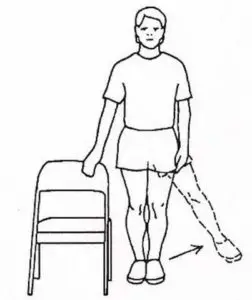
Make sure that your foot, knee, and hip are all facing directly forward. Keep your body straight. Lift your leg out to the side while maintaining a straight knee. Reposition your foot on the floor by lowering your leg gradually. Repeat 10 times. This exercise should take 2 minutes.
Do – 3 to 4 times a day.
Standing Hip Extensions
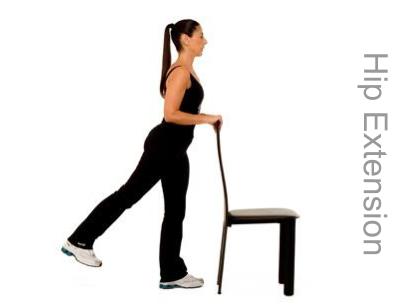
Lift your operated leg backward slowly. Try to keep your back straight. Hold for 2 or 3 counts. Return your foot to the floor. Repeat 10 times. This exercise should take 2 minutes.
Do 3 to 4 a day.
Early Activity
You’ll start walking small distances in your hospital room and carrying out simple daily tasks shortly after surgery. This early exercise improves healing and restores the strength and range of motion in your hip.
Walking
The greatest strategy to support your hip’s recovery is to walk properly. You will first need a walker or crutches to help you walk. How much weight to put on your leg will be determined by your therapist or surgeon.
Stair Climbing and Descending
Climbing stairs is a great way to build endurance and muscle, but it also needs flexibility.
You can only take one step at a time at first and will want a barrier for assistance. Always use your healthy leg to lead the way upstairs and your operated leg to lead the way down. Keep in mind to “down with the bad” and “up with the good.” Until you have mostly recovered your strength and mobility, you might wish to have someone assist you when climbing stairs. Use a barrier for balance at all times and avoid attempting to ascend stairs higher than the normal height of 7 inches.
FAQs
What are the risks involved with this surgery?
Risks include infection, blood loss, blood clots, and damage to nerves and arteries. Every safety measure is implemented to reduce these dangers, such as the use of antibiotics both before and after surgery, the temporary use of anticoagulants or compression devices, and meticulous surgical methods.
After having a total hip replacement, should I use heat or ice?
For the first several weeks following total hip replacement surgery, ice is recommended, especially if you are experiencing significant discomfort or swelling. After the initial swelling has subsided, you can apply heat or ice.
When may I take a shower or bath?
As soon as it’s comfortable for you, take a shower. A waterproof bandage will be applied to you, and it must be left on until your first clinic appointment. Until your surgery incision is completely healed, avoid taking a bath.
What are my restrictions after surgery?
After surgery, you will need to avoid crossing your legs for six weeks and maintain your hip and knee flexion at about ninety degrees. During that time, you will also need to sleep with a cushion between your knees.
how long does it take to walk normally after hip surgery?
Most patients should be able to walk for three to six weeks while using crutches. By the time of your six-week follow-up appointment, you may likely be getting around without the need of a walker or crutches. They can return to their regular activities in ten to twelve weeks following hip surgery.

